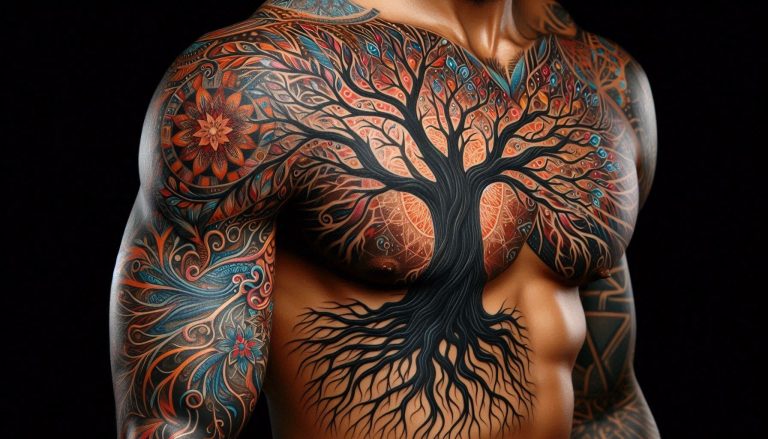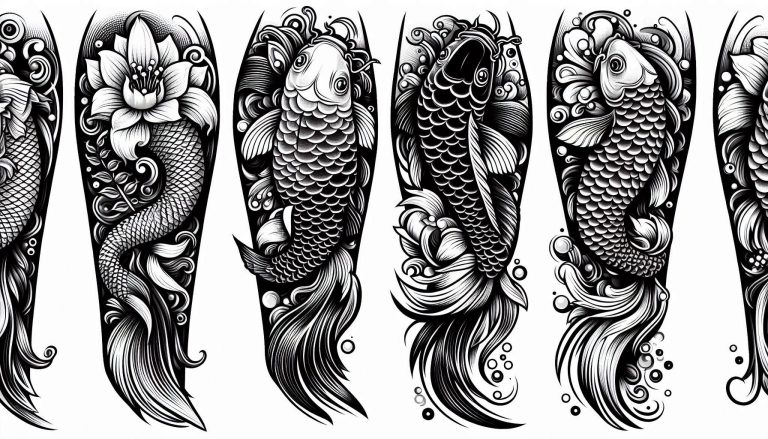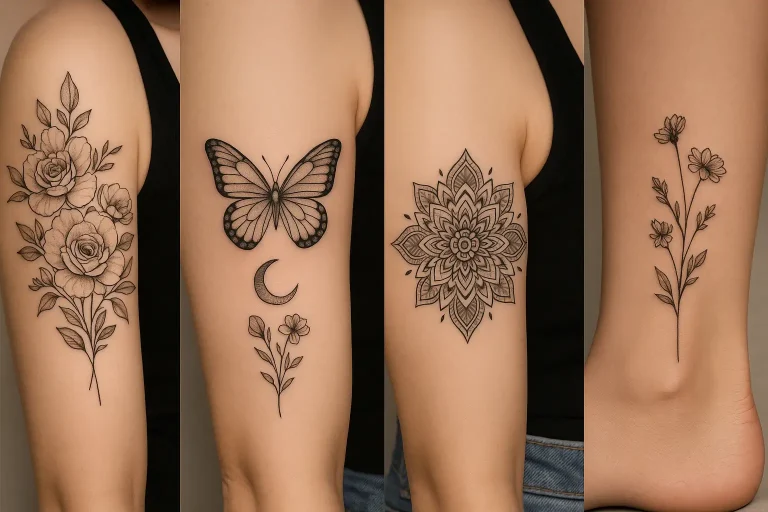
The Art and Symbolism of Rose Tattoos
As one of the most timeless and adaptable motifs in the realm of body art, rose tattoos have enthralled people from all walks of life. With their elaborate petals, vivid hues, and deep meaning, roses are more than just beautiful flowers; they are symbols of feelings, tales, and individual ideologies. This page explores the many facets of rose tattoos, including their meanings, the various demographics that wear them, the factors that contribute to their popularity, and particular variations like forearm, women’s, and men’s rose tattoos. By looking at these factors, we can see why the rose is still a popular option for ink lovers.
What is the Meaning of Rose Tattoos?

Often referred to as the “queen of flowers,” the rose has a diverse range of connotations that differ depending on the culture, setting, and personal interpretation. A rose tattoo is fundamentally a representation of love, beauty, and passion, but its meaning goes well beyond these universal concepts.
Love and Romance
Love, especially romantic love, is symbolized by the rose. Tattoos honoring partnerships, anniversaries, or soulmate connections frequently use red roses, which are particularly well-known as emblems of intense love and desire. A bouquet could symbolize many or several treasured connections, while a single red rose might symbolize a solitary, deep love.
Beauty and Aesthetic Appreciation
Roses are prized for their beautiful shape, which includes delicate petals and flowing curves. An appreciation of both internal and exterior beauty can be reflected in a rose tattoo. Some people use it as a reminder to embrace their own special charm or to see the beauty in the complexity of life.
Pain and Sacrifice
The rose’s thorns provide a striking contrast, signifying suffering, self-sacrifice, or the difficulties that come with beauty and love. A rose with noticeable thorns could stand for the notion that true beauty or love frequently entails hardships, demonstrating fortitude and fortitude in the face of difficulty.
Life and Transience
According to certain readings, a tattoo of a rose represents the transient aspect of life. While a withering or fading rose may represent mortality, loss, or the passing of time, a blooming rose represents energy and youth. Because of this dichotomy, rose tattoos are a moving option for anyone considering the transience of existence. download modified apks from apkworld
Cultural and Spiritual Significance
Roses have different connotations in different civilizations. The rose represents purity and divine love and is connected to the Virgin Mary in Christianity. It might stand for harmony and balance in Eastern traditions. A rose tattoo has mystical significance for certain people, acting as a talisman or a link to higher principles.
The color of the rose further refines its meaning:
- Red: Love, passion, respect.
- White: Purity, innocence, new beginnings.
- Yellow: Friendship, joy, care.
- Black: Death, mourning, rebellion.
- Pink: Gratitude, appreciation, gentleness.
- Blue: Fantasy, the unattainable, mystery.
People can add memories and feelings specific to their lives to their rose tattoos thanks to these multi-layered meanings.
Who Uses Rose Tattoos?

People of all ages, genders, and ethnic backgrounds find rose tattoos appealing. They are popular with a variety of organizations due to their universal meaning and aesthetic adaptability.
Tattoo Enthusiasts and Artists
Rose tattoos are common among people who are heavily involved in tattoo culture. Roses are frequently used as a base design by tattoo artists, either as stand-alone elements or as fills in more extensive designs. Whether in classic, realistic, or minimalist designs, their fine details and versatility serve as a canvas for exhibiting artistic talent.
Romantics and Sentimentalists
Rose tattoos are frequently chosen by people who value emotional expression to honor important relationships or life events. Some choose to ink a rose in honor of a loved one, combining beauty with a poignant recollection, while couples choose to have matching rose tattoos to represent their relationship.
Spiritual and Philosophical Thinkers
Rose tattoos resonate with people who are drawn to deeper meanings, whether they are existential, philosophical, or spiritual. The rose is a popular choice for people who see tattoos as a way to express their individual stories because of its dual nature of beauty and suffering, which is in line with reflections on the intricacies of life.
Rebels and Nonconformists
In the past, tattoos were linked to the counterculture, and people who embrace an outsider or rebellious identity continue to favor roses, particularly black or highly thorned ones. Roses are frequently used as a symbol of defiance or resiliency in the ink of bikers, rock artists, and punk fans.
Fashion-Forward Individuals
Rose tattoos are a fashion statement for some people. They are a stylish accessory for people who see their body as a blank canvas for personal expression because of their classic elegance and versatility, which can be seen in everything from delicate linework to striking conventional motifs.
Why People Use Rose Tattoos

Choosing to have a rose tattoo is a very personal choice that is influenced by a variety of cultural, aesthetic, and emotional factors. The main explanations for why this classic design appeals to individuals are listed below.
Emotional Expression
Rose tattoos are an effective way to express feelings that words cannot express. The rose captures complicated emotions in a single, powerful picture, whether it is being used to commemorate a friendship, celebrate love, or lament a loss. Many people find that getting a rose tattoo is a soothing way to commemorate a life milestone or change.
Aesthetic Appeal
There is no denying the rose’s aesthetic appeal. It is a unique option for tattoos because of its symmetrical petals, vivid colors, and capacity for fine detailing. There is a design to fit any taste thanks to the wide variety of techniques that artists can use to depict roses, including conventional, neo-traditional, realistic, watercolor, and geometric. Because of its adaptability, the rose can be enlarged for massive tattoos or reduced in size for delicate, subtle designs.
Symbol of Resilience
Those who have experienced hardship can relate to the contrast between the rose’s delicate petals and its jagged thorns. Rose tattoos are popular because they represent the belief that beauty may come from suffering and the ability to overcome obstacles. For those who have survived trauma, loss, or personal hardships, this makes the rose a popular choice.
Cultural and Historical Connection
With roots in millennia of literature, art, and cultural iconography, rose tattoos have an enduring appeal. Roses have traditionally been associated with significance, from Victorian floriography to medieval heraldry. Getting a rose tattoo allows some people to identify with a symbol that has stood the test of time and connect with this rich heritage.
Customization and Versatility
Few tattoo designs allow for as much personalization as a rose. Roses can be used with other components, such as skulls, daggers, hearts, clocks, or names, to create a distinctive story that goes beyond color and style. This versatility enables people to create a tattoo that feels uniquely their own, whether it’s a large mural on the back or a tiny piece on the wrist.
Social and Cultural Trends
As society’s perceptions of body art have changed, tattoos—including those featuring roses—have become increasingly popular. Previously stigmatized, tattoos are now accepted as commonplace ways to express one’s identity. Beautiful rose tattoo designs on social media sites like Instagram and Pinterest have stoked this craze and encouraged others to be tattooed.
Forearm Rose Tattoos

One of the most common locations for rose tattoos is the forearm, which provides a conspicuous yet adaptable canvas that works well for both striking and delicate patterns. Due of its accessibility, ease of display, and compatibility with other tattoos, forearm rose tattoos are popular.
Why Choose the Forearm?
Whether displaying a single bloom or an expansive bouquet, the forearm’s flat, extended surface is perfect for displaying intricate rose designs. Wearers can proudly show off their ink thanks to its visibility, and in formal or professional contexts, they can choose to hide it with long sleeves. Additionally, compared to more sensitive locations, the forearm is less painful during tattooing, which makes it a desirable option for beginners.
Design Variations
Forearm rose tattoos come in a range of styles:
- Traditional: Bold outlines, vibrant reds, and green leaves characterize American traditional rose tattoos, often paired with daggers or banners.
- Realism: Hyper-detailed roses with lifelike shading and texture, ideal for showcasing an artist’s skill.
- Minimalist: Simple linework or small, single roses for a understated, elegant look.
- Neo-Traditional: Combines traditional bold lines with softer colors and intricate details, often incorporating other floral elements.
Symbolism and Placement
Because of its exposure, a forearm rose tattoo frequently has personal meaning because it serves as a continual reminder of the wearer’s goals or background. A black rose on the outside forearm can represent public disobedience or grief, whilst a crimson rose on the inside forearm might represent a private love. Because of its prominence, the forearm also serves as a social statement, fostering interaction and connections with other art enthusiasts.
Practical Considerations
Because the forearm is less likely to experience friction or irritation throughout the healing process, forearm tattoos are comparatively simple to maintain. Sunscreen is necessary to preserve the radiance of a rose tattoo, though, as sun exposure can dull bright hues. The size of the forearm also permits future additions, like thorns, vines, or complimentary patterns to form a sleeve.
Women’s Rose Tattoos

In women’s tattoo culture, roses are particularly valued for their emotional depth, tenderness, and grace. Rose tattoos are popular among those who want to use flower images to convey their identity, strength, or personal journey, yet they are not just for women.
Feminine Aesthetic
Because they evoke grace and beauty, roses are naturally linked to femininity. Rose tattoos are popular among women because of their delicate details and gentle curves, which can be accentuated with neo-traditional, fine line, or watercolor techniques to create an ethereal effect. In order to highlight the body’s natural curves, tattoos are frequently placed on the wrist, ankle, shoulder, or thigh.
Empowerment and Strength
Rose tattoos are a symbol of empowerment for many women. The rose’s thorns are a symbol of fortitude and resiliency, representing the capacity to defend oneself while maintaining empathy and candor. Women who are negotiating social expectations, personal struggles, or career goals can relate to this dichotomy.
Personal Narratives
Rose tattoos are a common way for women to share their tales. A rose can be used to honor a loved one, celebrate a life event like marriage or maternity, or represent a time of recovery following adversity. In order to infuse the tattoo with personal significance, a lady can select a wilted rose to commemorate a previous loss or a flourishing rose to express newly discovered self-confidence.
Popular Designs
- Delicate Roses: Small, minimalist roses on the wrist or behind the ear, often in black or soft pink.
- Floral Bouquets: Roses paired with peonies, lavender, or lilies for a lush, romantic effect.
- Vintage Roses: Inspired by Victorian or botanical art, with intricate shading and muted colors.
- Thorned Roses: Emphasizing the thorns to highlight strength and self-protection.
Cultural Trends
Women’s rose tattoos have become more popular thanks to social media, where artists and influencers are presenting creative designs. Roses are a symbol of both strength and vulnerability, and movements like feminism and body positivity have also urged women to embrace tattoos as a way to love themselves.
Men’s Rose Tattoos

Although roses are frequently thought of as feminine, men also like the design because of its striking beauty, deep symbolic meaning, and cultural relevance. Strongness, devotion, and personal conviction are commonly reflected in men’s rose tattoos, which tend to have macho designs and locations.
Masculine Interpretations

Rose tattoos are frequently chosen by men to represent values like sacrifice, loyalty, or honor. A black rose may stand for conquering adversity or adopting a rebellious attitude, while a red rose might symbolize devotion to a family member or lover. Men are especially affected by the rose’s thorns, which stand for fortitude and the capacity to bear suffering.
Bold and Traditional Styles
Bold, highly contrasted designs are commonly used in men’s rose tattoos:
- American Traditional: Thick outlines, vibrant colors, and classic pairings like roses with skulls, daggers, or anchors.
- Black and Gray Realism: Detailed roses with dramatic shading, often covering the chest, arm, or back.
- Geometric Roses: Angular, symmetrical designs that blend floral and abstract elements for a modern edge.
- Large-Scale Pieces: Roses as part of sleeves or chest pieces, incorporating clocks, roses, or family names for a narrative effect.
Popular Placements
Men often opt for placements that emphasize strength or visibility:
- Chest: A rose over the heart symbolizes love or loyalty, often paired with names or dates.
- Upper Arm: Ideal for bold, standalone roses or as part of a sleeve.
- Hand or Knuckles: Small roses for a striking, rebellious statement.
- Back: Large, detailed roses as a centerpiece for expansive designs.
Cultural Context

Rose tattoos have long been used as a sign of identity in male-dominated subcultures such as rock music, the military, and biker gangs. For instance, a banner with a loved one’s name on it and a rose could be used to remember a family member or fallen colleague. Men’s rose tattoos have lost a lot of its stigma in recent years and are now a common way for people to express their uniqueness.
Breaking Stereotypes
Men are increasingly getting rose tattoos for their aesthetic value rather than their purely masculine meanings as gender norms change. To commemorate a kid or lover, a guy might select a delicate watercolor rose, defying conventional ideas of masculinity and promoting emotional transparency.
Conclusion
Themes of love, suffering, beauty, and resiliency are all interwoven in rose tattoos, which are much more than just a decorative option. Their capacity to adapt to different stories—whether it’s a realistic bouquet on a forearm, a thorned black rose on a man’s breast, or a vivid red rose on a woman’s wrist—is what makes them so appealing to all people. The rose’s complex meaning, which spans romance, sacrifice, and transience, guarantees its status as a classic tattoo design that appeals to both romantics and rebels as well as thinkers.
Rose tattoos offer countless customization options due of its cultural significance and aesthetic adaptability. They encourage users to accept their complexity and tell their tales to the world, bridging the gap between strength and vulnerability. Rose tattoos continue to be a potent example of the timeless appeal of body art, regardless of whether they are selected for their grace, emotional significance, or striking aesthetic impact. The rose, a timeless representation of the human spirit, will surely continue to flourish as tattoo culture develops.





